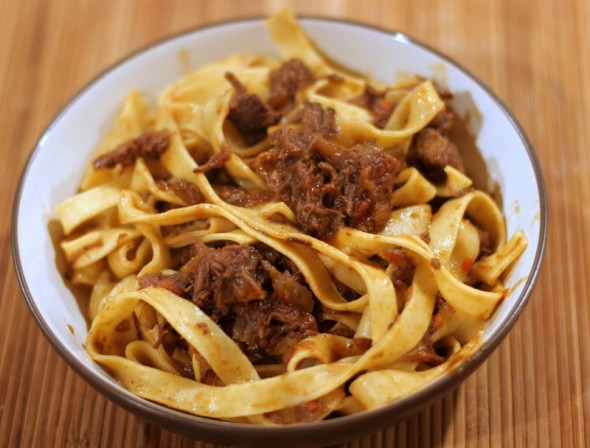I’ve worked with beef shanks once before, and it wasn’t pretty. The finished product was delicious, but I never thought I’d go near them again. The stress of prepping it outweighed the awesome finished product. That recipe called for boneless shanks that you just cut into pieces to braise. I couldn’t find a boneless shank, only a whole piece of shank with the bone. That I then had to trim and get off the bone. The membrane around the shank is so tough and slimy, it was really unpleasant for someone who had no idea what she was doing.
This recipe, from Anya Fernald in the January ’13 Food and Wine, seemed really promising from the start. You didn’t need to cube the shanks, just get bone-in shanks that were cut into 2″ steaks, for lack of a better word. And, luckily, Whole Foods had sliced shank rather than an entire piece of shank. The recipe says “trimmed” shanks, but I just left them on–I knew the membrane would just peel off easily after braising, so I didn’t even deal with it raw. And that’s exactly what it did.
Her recipe was served over polenta, but for us fresh fettuccine (couldn’t find any pappardelle) was perfection. And this recipe made a huge batch, enough to freeze 5 more servings of this for the future. It was such a gloriously thick ragu that by the time it cooled enough to portion and freeze I could slice it like a pie. I braised it the night before and served it the next day, so I just added a little more wine to reheat the portion. I put it in a covered saucepan for a couple of minutes on medium heat and it came right back. This. Was. Amazing. A great addition to my sauce making days.
Beef Shank Sauce (from the January 2013 Food and Wine magazine)
Makes 10 cups of sauce
5 pounds trimmed beef shanks, cut 2 inches thick
Kosher salt
Freshly ground pepper
3 tablespoons extra-virgin olive oil
2 onions, cut into 1/2-inch dice
4 celery ribs, cut into 1/2-inch dice
2 carrots, cut into 1/2-inch dice
2 cups dry red wine
One 28-ounce can crushed tomatoes
2 cups low-sodium vegetable broth or water
Cooked polenta or pasta, for serving

